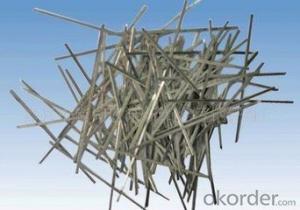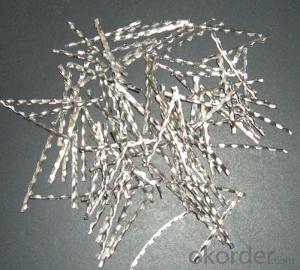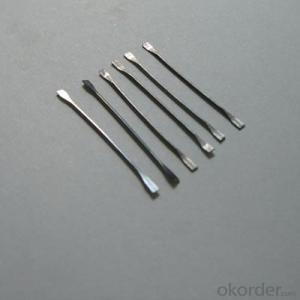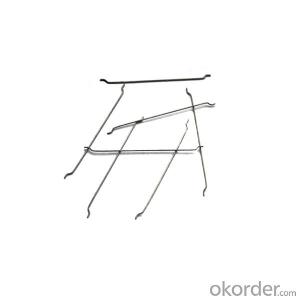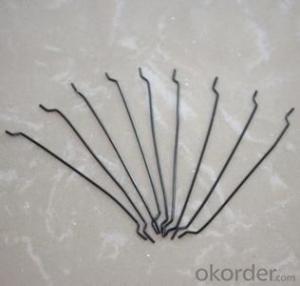Steel Fiber Loose From CNBM International
- Loading Port:
- Tianjin
- Payment Terms:
- TT OR LC
- Min Order Qty:
- 2000 kg
- Supply Capability:
- 30000 kg/month
OKorder Service Pledge
OKorder Financial Service
You Might Also Like
Quick Details
Place of Origin: Jiangsu, China (Mainland)
Model Number: HT-MC
Material: Color Steel
certificated: ISO 9001
Specifications
ISO 9001 certificated
2.70% for Europe, Middle Asia, America market
3.Have the most number of steel fiber machine in china
1. Material: low carbon steel wire or stainless steel
2.Diameter: 0.4mm-1.0mm
3.Length: meet your requirements
4.tensile strength >1000Mpa
6.Feature: excellent tensile,high tenacity,against cracking,impact and fatigue
7.Uses: highway road surface,tunnel,building,airport road surface and so on .
Straight Steel Fiber
1.ISO 9001 certificated
2.70% for Europe, Middle Asia, America market
3.Have the most number of steel fiber machine in china
Picture

Steel fiber
FAQ
certificated: ISO 9001
Technical advantages of Daye steel fiber:
A. Improve mechanical performance of concrete
B. Provide uniform distribution throughout concrete with excellent mixing
C. No balling or caking by adopt correct mixing method
D. Reduce concrete volume
E.Save construction time and cost
F.Reduce excavation volume
G.Available for jointless floor.
- Q:What is the typical length of melt extract stainless steel fiber?
- The typical length of melt extract stainless steel fiber is usually between 20 to 50 millimeters.
- Q:Can melt extract stainless steel fiber be used in the construction of tunnels?
- Yes, melt extract stainless steel fiber can be used in the construction of tunnels. Stainless steel fiber is known for its high tensile strength, durability, and resistance to corrosion, making it an excellent material for reinforcing concrete structures. In tunnel construction, stainless steel fiber can be added to the concrete mix to enhance its structural integrity, improve crack resistance, and increase the overall lifespan of the tunnel. The fibers help to distribute loads more evenly throughout the concrete, reducing the risk of cracking and improving its ability to withstand external forces such as vibrations and ground settlement. Furthermore, the corrosion resistance of stainless steel fiber ensures that it can withstand the harsh environments often encountered in tunnel construction, such as exposure to moisture and chemicals. Overall, the use of melt extract stainless steel fiber in tunnel construction can significantly enhance the robustness and longevity of the tunnels.
- Q:How does melt extract stainless steel fiber affect the shear strength of concrete?
- Melt extract stainless steel fiber has a significant impact on the shear strength of concrete. When added to the concrete mixture, these fibers enhance its overall structural integrity and resistance to shear forces. The fibers act as reinforcement by bridging cracks and distributing stress throughout the concrete matrix. The addition of melt extract stainless steel fibers increases the interlocking effect between the fibers and the surrounding concrete matrix, resulting in improved shear strength. These fibers effectively resist the forces that cause concrete to crack and fail under shear loads. They prevent the propagation of cracks by transferring shear stresses across the crack faces, thus increasing the shear resistance of the concrete. Furthermore, the high tensile strength and ductility of stainless steel fibers make them highly effective in enhancing the shear capacity of concrete. The fibers absorb energy during loading and dissipate it through deformation, which helps to delay and control the development of cracks. This ultimately improves the shear resistance and overall durability of the concrete structure. It is important to note that the effectiveness of melt extract stainless steel fibers in enhancing shear strength depends on various factors such as fiber content, aspect ratio, and distribution within the concrete mixture. The optimal dosage and distribution of fibers should be carefully considered to achieve the desired improvement in shear strength. Additionally, proper concrete mix design and fiber dispersion techniques are crucial to ensure the successful integration and performance of the stainless steel fibers. In summary, the addition of melt extract stainless steel fibers significantly improves the shear strength of concrete by enhancing its crack resistance, transferring shear stresses, and absorbing energy. These fibers play a crucial role in reinforcing the concrete matrix and increasing its overall structural integrity, making it more resistant to shear forces and improving the durability of the concrete structure.
- Q:What is the role of melt extract stainless steel fiber in refractory materials?
- The role of melt extract stainless steel fiber in refractory materials is primarily to enhance the mechanical properties and performance of the refractory material. Stainless steel fibers are added to the refractory mix to provide reinforcement and improve its resistance to thermal shock, cracking, and mechanical stress. The melt extract process ensures that the stainless steel fibers have a high degree of purity and uniformity, making them suitable for use in high-temperature applications. These fibers are typically added in small quantities to the refractory mix, but they significantly improve its strength, toughness, and resistance to wear and erosion. Stainless steel fibers also enhance the refractory material's thermal conductivity and dimensional stability, allowing it to withstand extreme temperatures without significant deformation or deterioration. They act as a reinforcement network within the refractory matrix, preventing the propagation of cracks and enhancing its overall durability. Furthermore, stainless steel fibers can improve the refractory material's resistance to chemical attack and corrosion, making it suitable for use in aggressive environments. They can also enhance the refractory's ability to retain heat, improving energy efficiency in various industrial applications. Overall, the addition of melt extract stainless steel fibers in refractory materials significantly enhances their mechanical strength, thermal stability, and resistance to various forms of degradation. This allows refractory materials to withstand harsh operating conditions and prolong their service life, making them essential in industries such as steelmaking, cement production, glass manufacturing, and petrochemical processing.
- Q:Are there any specific curing requirements for concrete with melt extract stainless steel fiber?
- Yes, there are specific curing requirements for concrete with melt extract stainless steel fiber. Firstly, it is important to note that the inclusion of stainless steel fibers in concrete can significantly enhance its mechanical properties, such as tensile strength and resistance to cracking. However, the presence of these fibers can also affect the curing process and require certain considerations. One key requirement is to ensure adequate moisture during the curing process. Concrete with stainless steel fibers should be kept moist to prevent premature drying, as this can lead to shrinkage and cracking. Moist curing methods, such as using wet burlap or plastic sheets, can be employed to retain moisture and promote proper hydration of the concrete. Additionally, temperature control is crucial during the curing period. High temperatures can accelerate the hydration process, leading to increased shrinkage and potential cracking. On the other hand, low temperatures can hinder the curing process and result in reduced strength development. Therefore, maintaining a moderate and consistent temperature is essential for the proper curing of concrete with stainless steel fibers. Furthermore, it is advisable to extend the duration of the curing period for concrete with stainless steel fibers. This is because the fibers may impede the movement of water within the concrete matrix, slowing down the hydration process. By extending the curing time, the concrete has more opportunity to develop its desired strength and durability. Lastly, it is crucial to follow the manufacturer's recommendations regarding curing requirements for concrete with melt extract stainless steel fibers. Different fiber types and manufacturers may have specific guidelines and recommendations for curing, which should be followed to ensure optimal performance of the concrete. In summary, curing requirements for concrete with melt extract stainless steel fibers include maintaining moisture, controlling temperature, extending the curing period, and following manufacturer guidelines. By adhering to these requirements, the concrete can achieve its desired strength and durability while benefiting from the enhanced properties provided by the stainless steel fibers.
- Q:Can melt extract stainless steel fiber be used in hydraulic structure construction?
- Melt extract stainless steel fiber is indeed applicable in the construction of hydraulic structures. With its enhanced durability and resistance to corrosion, stainless steel fiber proves to be suitable for use in hydraulic structures that come into contact with water and other corrosive elements. Its versatility allows for its application in various areas, such as slabs, tunnel linings, and foundations, to improve the strength of structures and resistance against cracks. Moreover, the use of stainless steel fiber can also enhance the concrete's ductility and toughness, resulting in a better ability to withstand impact and seismic forces. Hence, melt extract stainless steel fiber serves as a feasible choice to reinforce hydraulic structures, ensuring their long-term stability and performance.
- Q:How does melt extract stainless steel fiber impact the load transfer between concrete layers?
- Melt extract stainless steel fibers enhance load transfer between concrete layers by improving the bond strength and overall mechanical properties of the concrete. These fibers act as reinforcement, dispersing stress and preventing crack propagation, thereby increasing the load-carrying capacity and durability of the concrete structure.
- Q:Is melt extract stainless steel fiber suitable for use in pre-stressed concrete?
- Yes, melt extract stainless steel fiber is suitable for use in pre-stressed concrete.
- Q:Can melt extract stainless steel fiber be used in precast tunnel segments?
- Yes, melt extract stainless steel fiber can be used in precast tunnel segments. These fibers are highly durable and possess excellent tensile strength, making them suitable for reinforcing concrete in tunnel construction. They help improve the structural integrity and increase the resistance to cracking and spalling, ultimately enhancing the lifespan and performance of precast tunnel segments.
- Q:Can melt extract stainless steel fiber be used in fiber-reinforced asphalt concrete?
- Certainly, fiber-reinforced asphalt concrete can incorporate melt extract stainless steel fiber. The inclusion of these fibers in asphalt mixtures aims to enhance their mechanical properties and optimize their performance. Melt extract stainless steel fibers possess various advantages, including remarkable tensile strength, excellent corrosion resistance, and outstanding durability. These desirable properties render them suitable for utilization in fiber-reinforced asphalt concrete, thereby augmenting its tensile strength, crack resistance, and overall longevity. Moreover, the addition of melt extract stainless steel fibers can effectively mitigate reflective cracking, rutting, and fatigue failure in the asphalt concrete, making them a highly valuable component in the mixture.
1. Manufacturer Overview |
|
|---|---|
| Location | |
| Year Established | |
| Annual Output Value | |
| Main Markets | |
| Company Certifications | |
2. Manufacturer Certificates |
|
|---|---|
| a) Certification Name | |
| Range | |
| Reference | |
| Validity Period | |
3. Manufacturer Capability |
|
|---|---|
| a)Trade Capacity | |
| Nearest Port | |
| Export Percentage | |
| No.of Employees in Trade Department | |
| Language Spoken: | |
| b)Factory Information | |
| Factory Size: | |
| No. of Production Lines | |
| Contract Manufacturing | |
| Product Price Range | |
Send your message to us
Steel Fiber Loose From CNBM International
- Loading Port:
- Tianjin
- Payment Terms:
- TT OR LC
- Min Order Qty:
- 2000 kg
- Supply Capability:
- 30000 kg/month
OKorder Service Pledge
OKorder Financial Service
Similar products
New products
Hot products
Related keywords
